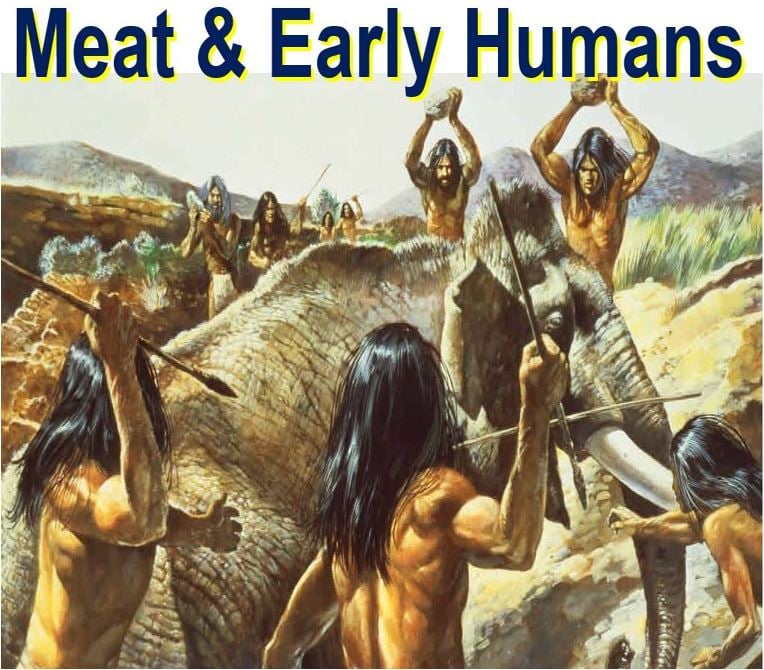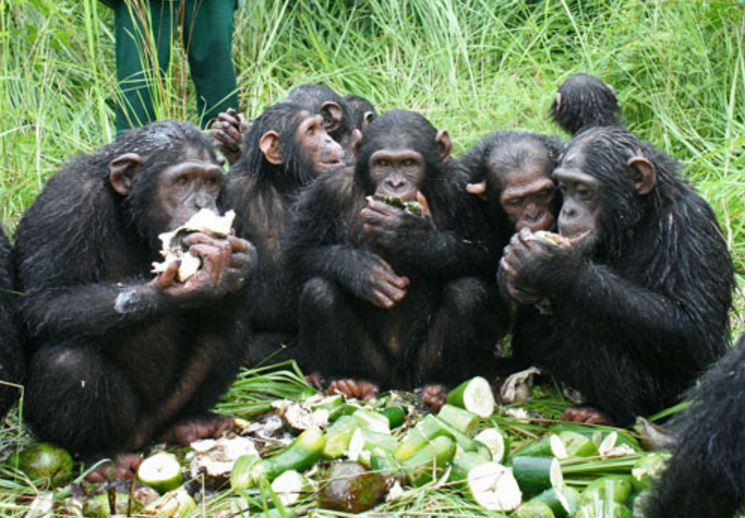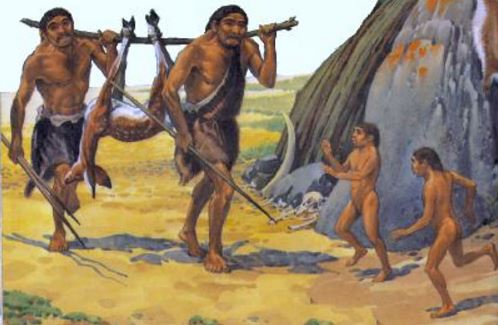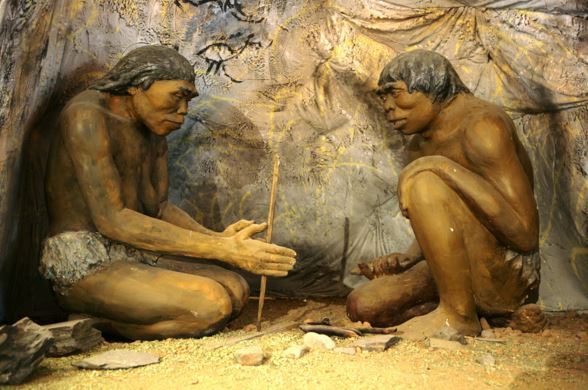Human evolution, which advanced much more rapidly than in other animals, is linked to less time spent chewing due mainly to the processing of meat, which we started doing about two to three million years ago, say two scientists from the Department of Human Evolutionary Biology at Harvard University.
By adding meat to their diets and using stone tools to process their food, early humans probably saved as many as 2,500,000 chews each years, which resulted in smaller teeth, face and guts, and growth in brain size.
We all enjoy a few leisurely meals each day, however, we hardly spend any time or use up much muscular effort chewing our food, compared to other animals, including our non-human primate cousins.
 When we started processing meat and vegetables with stone tools over 2 million years ago, we started to spend much less time chewing, which changed the shape of our heads, and the size of our teeth and guts. (Image: tarpits.org)
When we started processing meat and vegetables with stone tools over 2 million years ago, we started to spend much less time chewing, which changed the shape of our heads, and the size of our teeth and guts. (Image: tarpits.org)
This kind of easy eating is very unusual. Our closest relatives, chimpanzees for example, spend nearly half their waking hours chewing, and with considerably greater force.
When did eating get easier
When did our eating become so relatively easy, and what were its consequences? A new Harvard study found that from two to three million years ago, our ancient ancestors began to spend significantly less time and effort chewing by adding meat to their diets.
They also used stone tools to process their food. The scientists, who published their study and findings in the prestigious journal Nature (citation below), wrote that the chewing time and effort saved helped make us the humans we are today.
One of human evolution’s great mysteries is how species such as Homo erectus evolved smaller guts, faces and teeth, but yet managed to obtain more energy from food to pay for their larger brains and bodies before they started to cook.
 Chimpanzees spend nearly half their waking hours chewing.
Chimpanzees spend nearly half their waking hours chewing.
First author, Katie Zink, a lecturer working in the lab of Daniel Lieberman, the Edwin M. Lerner II Professor of Biological Sciences, said:
“What we showed is that…by processing food, especially meat, before eating it, humans not only decrease the effort needed to chew it, but also chew it much more effectively.”
By altering their diets to include just 33% meat, slicing meat and pounding vegetables – processing their food – before eating, Prof. Zink and Prof. Lieberman found that the muscular effort needed per chew and the total number of chews required per day declined by nearly 20%.
The researchers also found that by slicing meat with the types of simple tools that were available over 2 million years ago, ancient humans were able to swallow much smaller and more easily digestible pieces than would have been possible had they not used the tools.
Prof. Zink said:
“Eating meat and using stone tools to process food apparently made possible key reductions in the jaws, teeth and chewing muscles that occurred during human evolution.”
Volunteers chewed raw meat and spat it out
However, testing a process as basic as chewing is no easy task, neither is it attractive, the authors said.
Prof. Lieberman said:
“What Katie did was creative but sometimes, frankly, a little stomach-churning. Not only did she have people come into the lab, chew raw meat and other foods, and spit them out, but then she had to analyze the stuff.”
 Sometimes hunters would come home empty-handed, something other animals like apes would not be able to do – they’d have to spend the whole night seeking food and eating. Division of labour among early humans meant that somebody else in the group probably came home with a kill.
Sometimes hunters would come home empty-handed, something other animals like apes would not be able to do – they’d have to spend the whole night seeking food and eating. Division of labour among early humans meant that somebody else in the group probably came home with a kill.
The study volunteers did not chew just any kind of food or meat. In order to approximate the texture and toughness of the game that our early ancestors ate, Professors Zink and Lieberman (after a great deal of experimentation) settled on using goat.
Volunteers had to chew goat while Prof. Zink used instruments attached to their jaws to measure how much effort was used.
In each experiment, the study participants were given a selection of foods in random order. They had been prepared in several different ways – pounded, sliced, raw, and cooked goat, as well as yams, beets, carrots and other vegetables.
After chewing each mouthful until they would normally swallow, the volunteers spat out the food. The individual food particles from the chewed up food were spread out onto a tray. Scientists photographed them and digitally measured their sizes.
 When early humans started cooking food with fire, even less time was spent chewing each day.
When early humans started cooking food with fire, even less time was spent chewing each day.
Prof. Lieberman said:
“What we found was that humans cannot eat raw meat effectively with their low-crested teeth. When you give people raw goat, they chew and chew and chew, and most of the goat is still one big clump – it’s like chewing gum.”
“But once you start processing it mechanically, even just slicing it, the effects on chewing performance are dramatic.”
Why study chewing at all?
Lieberman explained:
“Chewing is one of the key characteristics of being a mammal. Most other animals, like reptiles, barely chew their food — they just swallow it whole.”
“The evolution of the ability to chew food into smaller particles gave mammals a big boost of extra energy because smaller particles have a higher surface area to volume ratio, allowing digestive enzymes to then break food down more efficiently.”
The majority of mammals, however, eat a relatively low-quality diet. Cows, for example, spend most of their day chewing grass. Even our closest ape relatives, whose diets consist mainly of fruit, have to spend almost half their day chewing to get enough energy from their food, the authors explained.
Prof. Lieberman said:
“But we humans have done something really remarkable. We eat even higher-quality foods than chimpanzees, and spend an order of magnitude less time chewing them.”
Meat hard to chew
However, making that change presented our ancient ancestors with a new challenge. One of the key components to that higher-quality diet is meat, which – in spite of being calorically dense – is extremely difficult for humans to chew effectively.
Prof. Zink explained:
“Meat has a lot of nutrients, but it is also very elastic. You can think of it as being like a rubber band. So the problem is that we can’t break it down with our flat, low-cusped teeth.”
“But if you slice it up, then you do not need to use your teeth to break it down as much, and you swallow much smaller particles. Cooking makes chewing even easier.”
Professors Lieberman and Zink said that the pre-processing of food and the reductions in chewing effort that came with it may have opened to door to one of the key lifestyle changes in our evolution – the emergence of a hunter-gatherer lifestyle.
Prof. Lieberman said:
“With the origin of the genus Homo…we went from having snouts and big teeth and large chewing muscles to having smaller teeth, smaller chewing muscles, and snoutless faces. Those changes, and others, allowed for selection for speech and other shifts in the head, like bigger brains.”
“Underlying that, to some extent, is the simplest technology of all: slicing meat into smaller pieces, and pounding vegetables before you chew them.”
The impact of higher-quality diets and easier chewing on our ancient ancestors is evident if we imagine what day-to-day life must have been like all those millions of years ago.
Imagine an early human went out hunting for antelopes like kudu or impala, and came back at the end of the day empty-handed, which must have occurred fairly often then. Chimpanzees could not survive that way – they would have to spend the whole night eating.
Humans benefited from a division of labour
Prof. Lieberman said:
“Following the invention of hunting and gathering, though, humans can benefit from a division of labor. Someone else may have come back with an impala, or some tubers you could eat.”
“And instead of spending all night eating it, you’d spend a lot less time, energy and effort to chew it by pounding it or cutting it with just a few stone tools. What a dramatic shift!”
While many aspects of our biology changed when the genus Homo evolved, the authors said that processing food before eating must surely have played a significant role.
Prof. Lieberman said:
“One of the innovations that helped make us human is cutting up and pounding our food. Extra-oral processing first by using stone tools and then by cooking played a very important role in human evolution because it released selection for big faces and big teeth, which then enabled selection for shorter faces which were important for speech, and enabled us to grow big brains and have large bodies. We are partly who we are because we chew less.”
Citation: “Impact of meat and Lower Palaeolithic food processing techniques on chewing in humans,” Katherine D. Zink & Daniel E. Lieberman. Nature. 9 March 2016. DOI: 10.1038/nature16990.
Video – From Ape to Human
